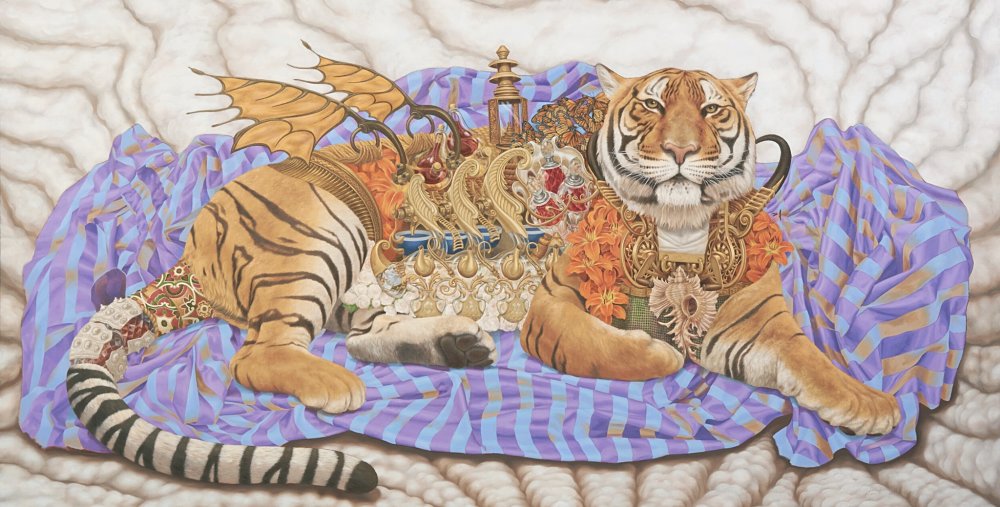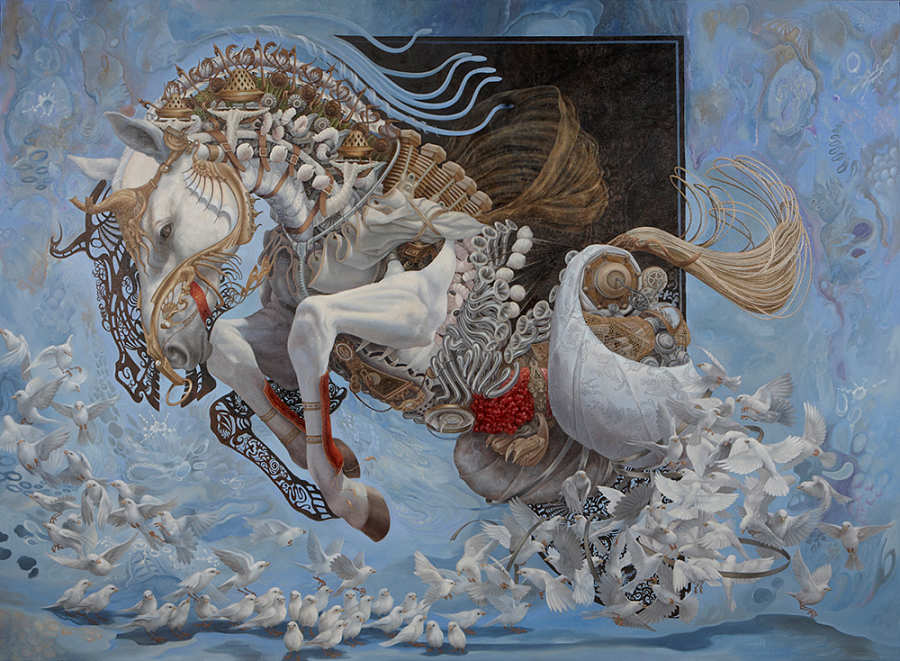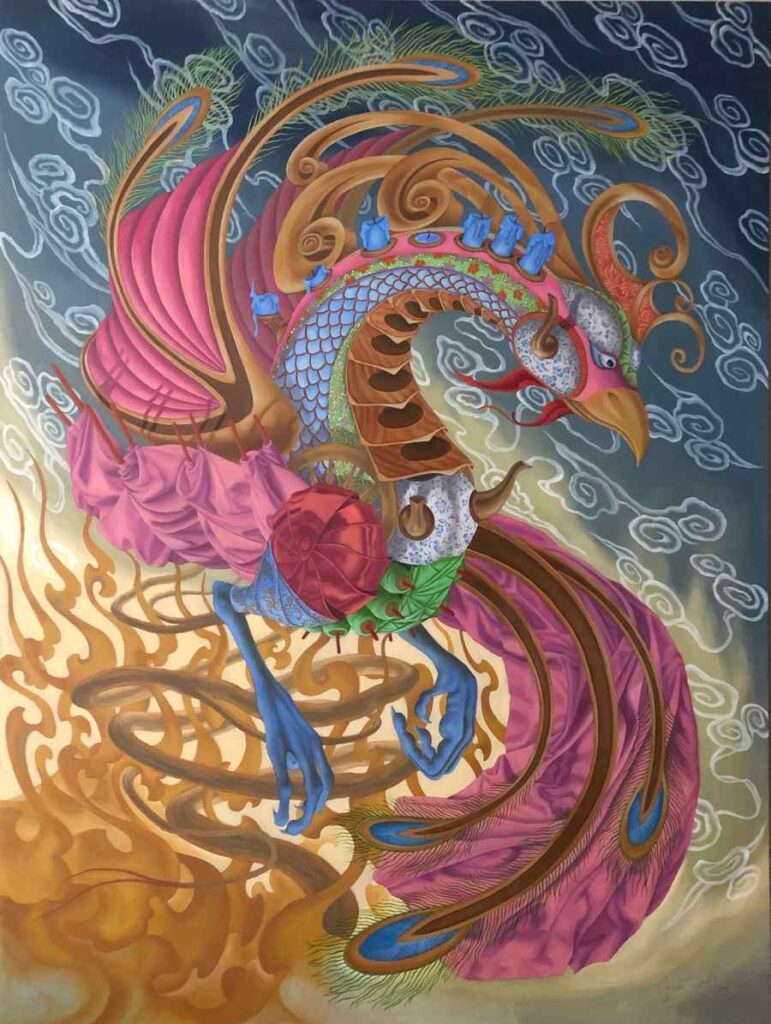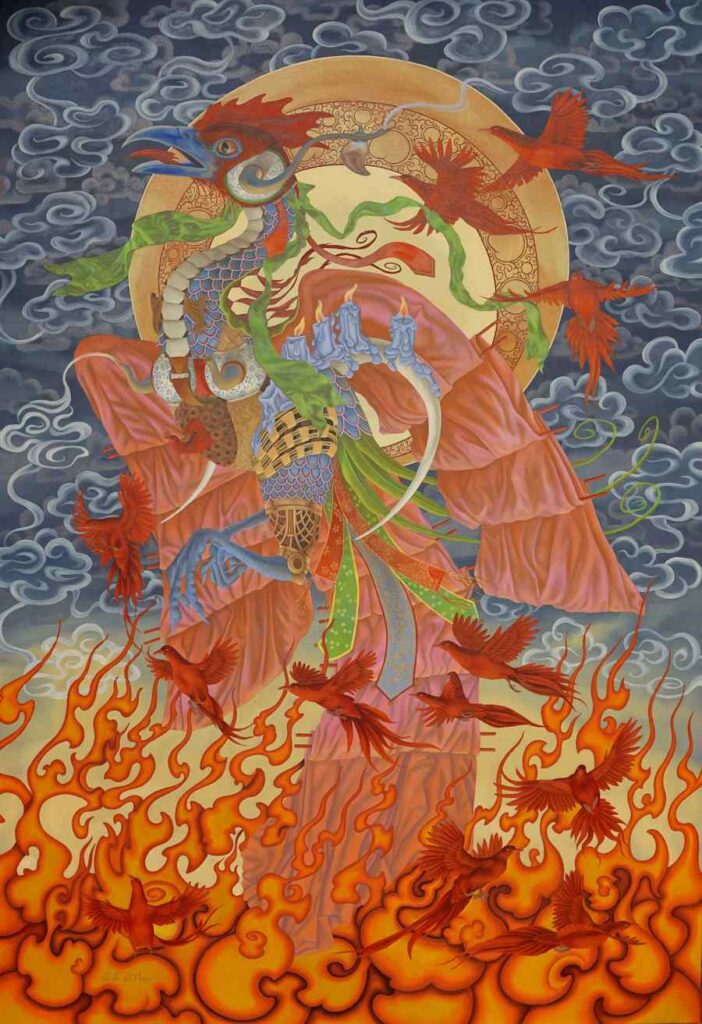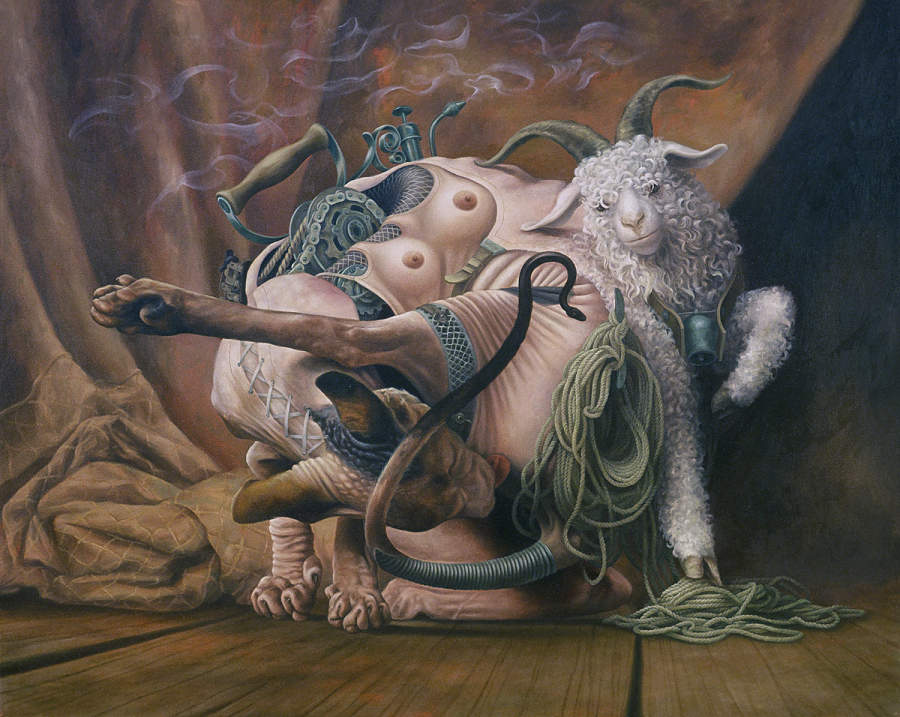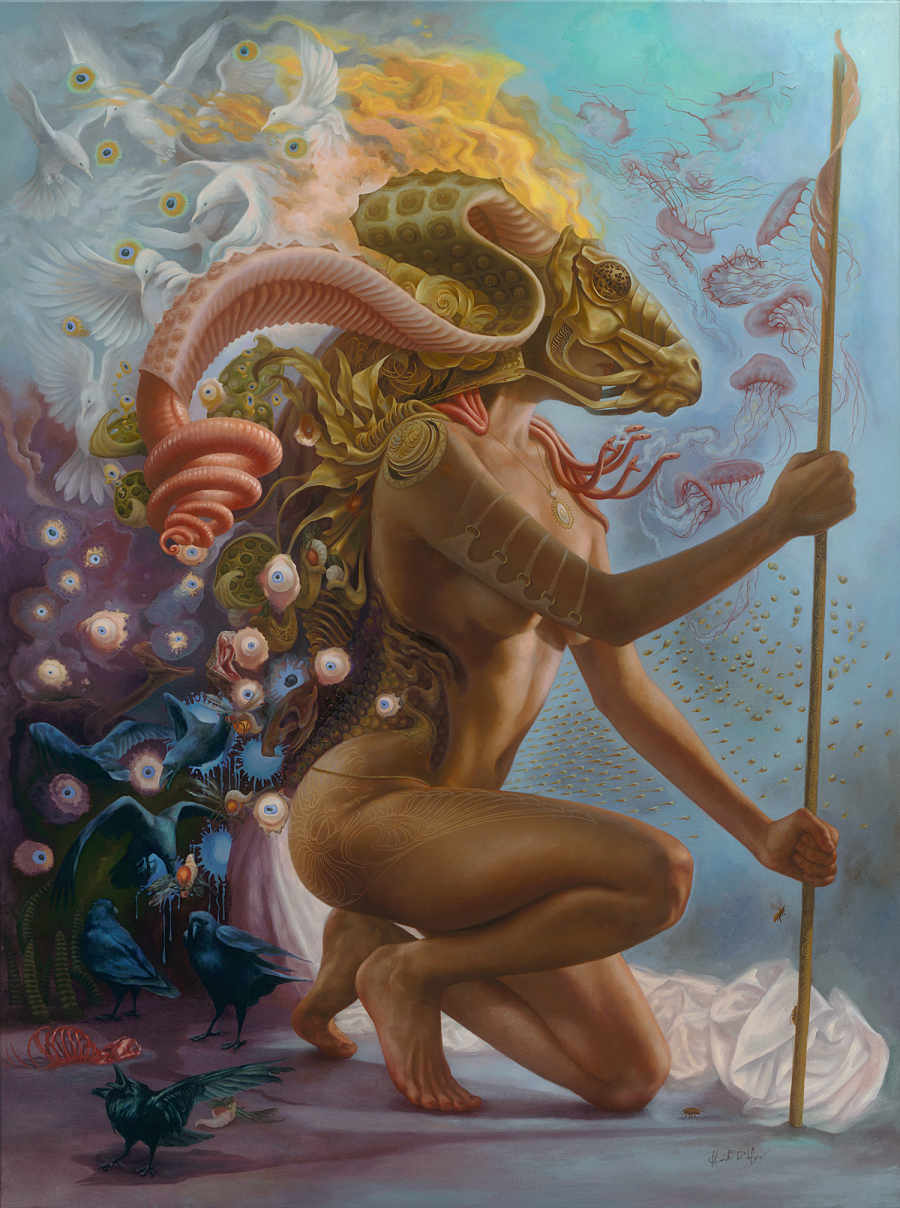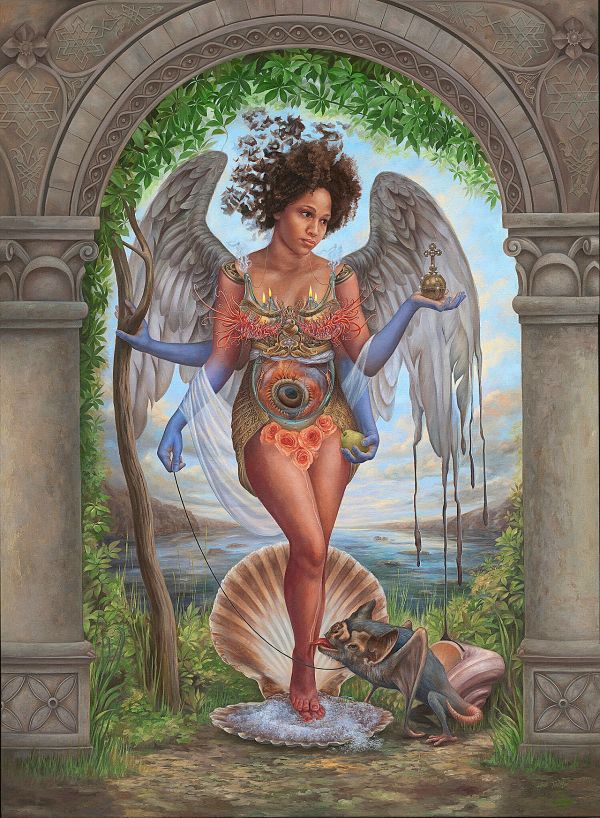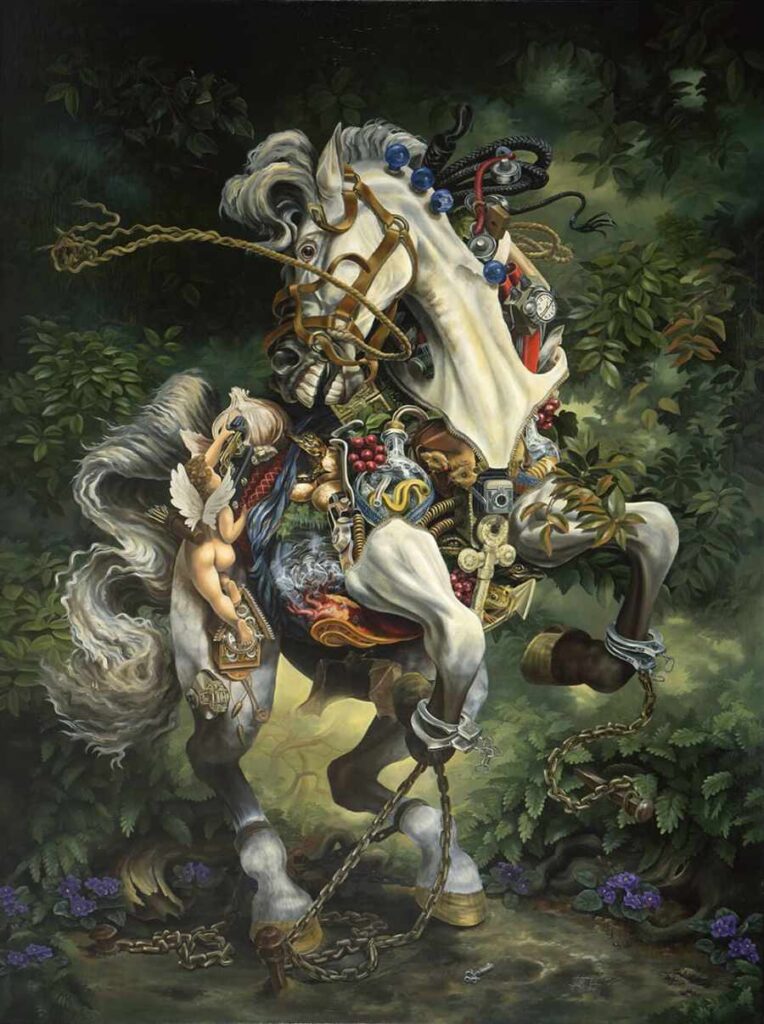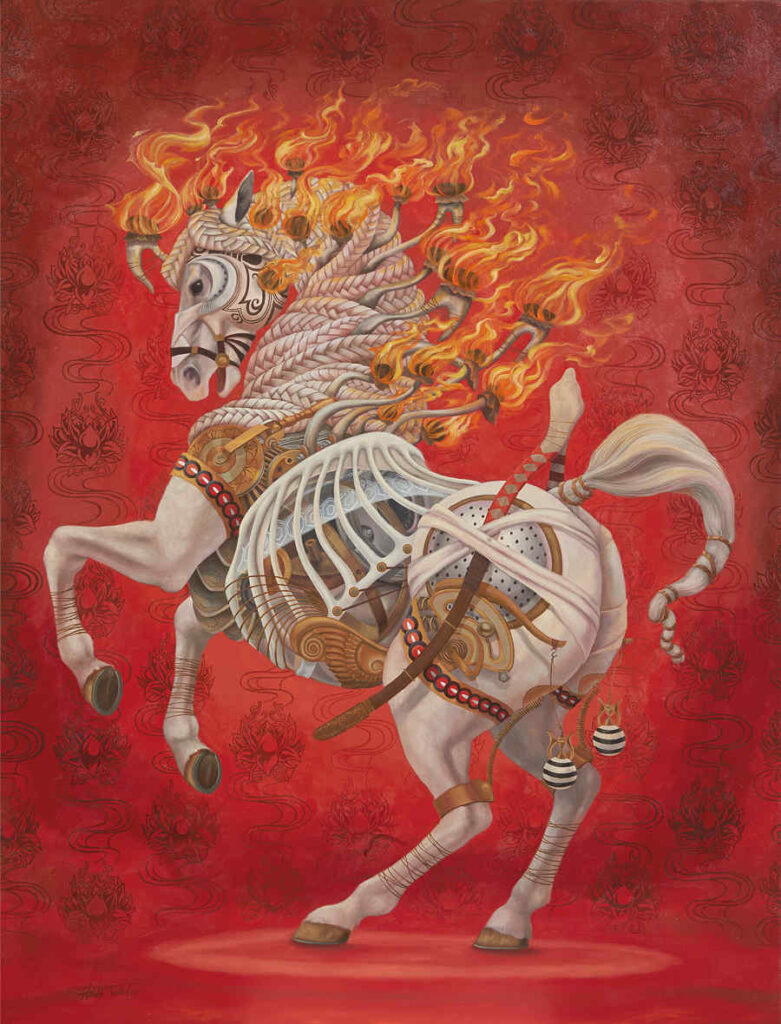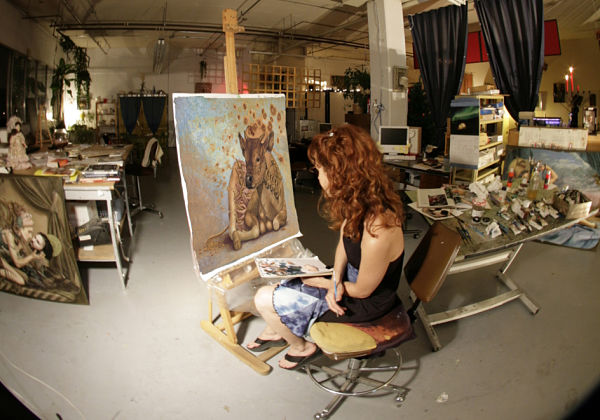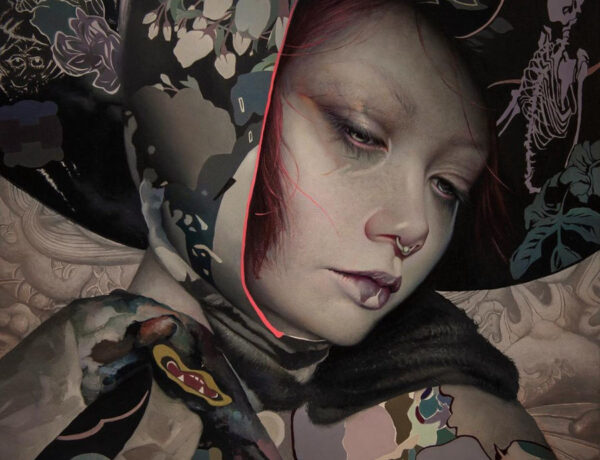Exclusive Interview with Heidi Taillefer, 1st Prize Winner of the INPRNT Traditional Art Award, 2020 Beautiful Bizarre Art Prize
Canadian artist Heidi Taillefer paints surrealist fantasias, a cacophony of animalistic composites on canvas. She is the winner of the INPRNT Traditional Art Award, part of the 2020 Beautiful Bizarre Art Prize, for her work Silkworm. Heidi is an intuitive painter, able to assemble seemingly randomised objects into paragons of allegory. Her paintings are absolute alchemy, blending ideas from myth, science and morality into resonating works that inspire our own reflection on what it is to be human in the enigmatic world we all inhabit.
Depending on your impression, there is a comforting or rather sad message within Heidi’s works: despite the birth of a technological age, humanity – in all of its beauty and blemish – has remained unchanged. As worded by Aldous Huxley, “Technological progress has merely provided us with more efficient means for going backwards.” We all remain stumbling through life, never quite enlightened. In a way, Heidi Taillefer’s works are reflective of the mythic method; a manipulation of antiquity and contemporaneity to create artworks symbolic of an attempt to find a sense of unity, reason, beauty in a somewhat entropic present. The mystique of Heidi Taillefer’s paintings often transports us to the sublime, into worlds beyond our mere mortal imaginations. However, they are also grounded in knowledge. Her works are all carefully considered, a curation of myth, philosophy and cultural wisdom.
In the following interview, Heidi Taillefer becomes a storyteller, clarifying her artistic vision and sharing what it means to be a contemporary artist.
Enter the 2021 Beautiful Bizarre Art Prize in any of the four Award categories: RAYMAR Traditional Art Award, INPRNT Photography Award, iCanvas Digital Art Award, Yasha Young Projects Sculpture Award, plus our People’s Choice Award, for your chance to receive global exposure for your work and share in over US$45,000 in cash and prizes!
I thought of the idea of soulful progression in this lifetime and our different selves, both the shadow and light sides. I researched symbols to represent Buddhism and more Eastern cosmologies, since I was questioning the idea of reincarnation, and combined that with elements found in Western belief systems such as Christianity. The result is a syncretic portrayal of the afterlife.
Congratulations! You’re the winner of the INPRNT Traditional Art Award as part of the 2020 Beautiful Bizarre Art Prize. Please describe your award winning work, Silkworm.
Silkworm was inspired after a trip to Bali in 2013, which is where I got the idea for the shadow puppet motif in the background of the image. When I was delving deeply into meditation and learning about various cosmologies in the East and West, I wanted to portray something divine, depicting the heavens which is what you feel you connect with during meditation; a kind of soul consciousness. In the process, I came upon an image of a horse jumping which became my reference, and after a brainstorming session, I anchored the idea of the shadow puppet design.
I thought of the idea of soulful progression in this lifetime and our different selves, both the shadow and light sides. I researched symbols to represent Buddhism and more Eastern cosmologies, since I was questioning the idea of reincarnation, and combined that with elements found in Western belief systems such as Christianity. The result is a syncretic portrayal of the afterlife. As with my usual work, I use the language of mechanism to depict themes that address our human condition, which never changes despite our increasing merger with technology.
Describe your earliest memory as an artist.
When I was four years old, I glued a collage out of pure white paper on a black background depicting a grasshopper, which to this day I remember as being really good (although it is now lost, I also confirmed my satisfaction with this collage well into my twenties when I looked at it again). I was thrilled and showed it to my mother with tremendous pride; she is also an artist and was always overseeing and encouraging art projects from the time I was able to hold a crayon. At six years old, I remember walking around the crescent we lived on trying to sell my drawings for 25 cents, which foretold my destiny as a professional artist. Then, at eight years old, my mother taught me to paint with watercolour, which helped me broaden my artistic horizons.
Creating art is a lot like driving with a diesel engine because it can be very slow to start. But once it gets going: it is thrilling, uplifting, and very soothing.
How do you think your approach to art has changed?
I’d say that I paint mostly for myself rather than for an audience. When I first began as an artist, it was in combination with commercial art, where you work to produce an image according to the direction of an art director and a client. That was to make a living, and although I painted fine artworks alongside that career, those paintings were to provide works to a Montreal gallery who sold them almost immediately. I was advised to put less detail in my work to produce faster, but that part I didn’t really listen to although I do notice my work is simpler now than it was in the past. Eventually, I decided to paint very personal images related to experiences I was living during a very tumultuous time in my life, which enriched my work but made it more difficult to sell.
By now, especially since my focus is more on getting the message out rather than selling, I notice I paint for myself, although since I love beauty it might lend itself well to sales.
In three words, how does it feel to create art?
Creating art is a lot like driving with a diesel engine because it can be very slow to start. But once it gets going: it is thrilling, uplifting, and very soothing.
I use the language of mechanism to depict themes that address our human condition, which never changes despite our increasing merger with technology.
Heidi Taillefer
Has art, in some ways, been a sanctuary for you?
Art has been a mixed bag of feelings for me. When I was younger, I never thought I would become an artist; my father, who was a lawyer, greatly influenced me although he suggested I try something other than Law because the industry was saturated. I actually decided to become an artist after a bad waitressing experience in the Yukon when I was 21, figuring I would not have to work for anyone, but I was totally unaware of the entrepreneurial challenges and politics that can exist in the industry, so I failed to escape what I was trying to avoid.
Normally when I create I get lost in the ideas and images I come up with, which is very much a sanctuary, and I feel like there is nothing that can compare with the thrill of revelation when getting an idea or the satisfaction of completing a successful depiction of the idea I had in mind. It lifts me out of the doldrums, and if I am not painting or working on a project, I notice my mood sink into a mysterious sadness, which is quickly remedied by the creative process.
I have had a lot of success as an artist (which was not easy to secure!), but I also feel like my heart got broken on numerous occasions due to the politics in the gallery business. That, and because of some flagrant misrepresentation of who I am as an artist and a person, which might be what happens when you start to become more known in the community. I actually became quite tapped out over the last 10 years and painting has been a struggle because of that, but I never stopped. However, there were times when I considered going into animation or some other artistic field because I lost that wonderful joy of painting.
In the last few years, I have also become my father’s primary caregiver since he has Alzheimers, which has shifted my focus away from art somewhat; but it has allowed me to rest in terms of the art, and I do still manage to produce – though maybe not as much as before. All things move in cycles throughout life, and right now caring for my father seems to be a good reason to take more of a break from art to get back on track with a renewed focus later on.
I am often depicting themes in my paintings which address aspects of the human condition, as an inescapable plight we must contend with and which no artificial technological aid can address.
Throughout your career, you seem to have experimented with a range of artistic media. Explain your affinity for oil colours.
My mother first introduced me to watercolour when I was eight years old. I was also taught to paint with watercolour in weekly art classes that I took for the next ten years. After I left those classes and began working on my own at home, I came across an artist who recommended I paint my watercolour robots in acrylic because it would be much more vibrant and striking.
So, I took a weekend workshop on painting with acrylic, which can be somewhat similar to watercolour, but in the workshop, we did not work with paper which absorbs water, rather is was on gessoed board, which does not absorb a thing, and I was totally unaccustomed to it. It was a total failure. A commercial illustrator also encouraged me to try and apply airbrushing to my robots. That required liquid acrylic paints, so I kept practising to master the medium. I eventually became used to acrylics and learned to love the speed with which I could work.
On another occasion, that same commercial illustrator suggested I try oil paints because of its greater vibrancy and buttery feel when handling the paint. So in 1998, I tried my first oil painting and it was a total disaster at the onset, completely the opposite to acrylic or watercolour, so I really disliked the medium, but after leaving it to dry overnight I reworked the painting and better understood how the paint could be handled. I have not turned back since.
I love working with a traditional medium that is not made of plastic, is vibrant and has stood the test of time, and that smells so divine (Along with linen), and I love it when its perfume fills the air.
I love Aesop’s fable of the scorpion and the frog, although I think this finds itself told in many cultures. In the fable, the scorpion asks the frog to help it cross the river, which the frog is hesitant to do since the scorpion is known to sting. The scorpion promises to be good, but halfway across the river it stings the frog which begins to kill it, and as the frog asks why the scorpion would do something to kill it and drown itself, the scorpion simply replies, “Because it’s my nature.”
I am often depicting themes in my paintings which address aspects of the human condition, as an inescapable plight we must contend with and which no artificial technological aid can address. It is a favourite of mine because I find that it encapsulates so much of what I already incorporate in my work.
Art as protest. What is one cause you’ve supported through your work?
The most recent cause I can think of which I’ve supported with my work is the Black Lives Matter movement in 2020. In 2010, I had produced a painting of a woman of colour posing as Venus in a clamshell (below), holding the Sovereign’s orb in one hand, and a demon on a leash succumbing to her charms in the other hand. The title is “Pelican and the Vampire”. It is a painting about unconditional love, through the pathway of the most unjustly maligned reaching exaltation, which is the highest-ranking anyone can achieve. It was featured in 2010 as the poster image for the Montreal International Fantasia Film Festival. Still, I was told it received a really negative backlash by many viewers, on account of what seemed to be a racist reaction.
Like most people, I love beauty and am a bit of an aesthete, so when I choose a model it is because I find him or her to be beautiful. I was totally dumbfounded, shocked, hurt, and deeply disappointed after learning of this reaction which to me made no sense because it was a sensual image of a woman posing as a goddess defeating the demons of ignorance, which I thought was obvious at first glance. I was never asked to provide an image for the festival afterwards, even though it was my third one and they had wanted to take me on board on a yearly basis as a literal poster girl. Also, I donate prints to various causes in support of Alzheimers or cancer or most recently palliative care, but I’d say that was my contribution to the BLM movement, way back in 2010.
In a National Geographic survey, I once read that the happiest communities in the world are the tribes of New Guinea, where there is the least technology of all. Still, I am not a Luddite, and I am grateful for the advances we have made technologically in health and society.
However, I will say that we are probably going to have to rely heavily on technology at this point to remedy our impact on the environment. If the internet had existed as it does today back in the early ’90s when I was going door to door in Montreal and NY trying to show my illustrator’s portfolio or mailing slides to galleries, I wonder if I might not have had much more success (much more easily) as an artist. I am still not very tech-savvy and do not master marketing efforts on social media, which could greatly increase my visibility. Still, I do use technology to communicate better, and I feel it has improved my life.
However, as we can see in the past few years, social media has proven itself to be a double-edged sword. We have not only an “information” but a “misinformation” overload that is creating enormous upheavals in society, as seen in the US especially. I am not sure if I fear AI particularly, I doubt machines would learn the same nefarious inclinations we as humans might have. However, I am aware of the importance of safeguarding ourselves to ensure that we do not make ourselves obsolete. I do think we will likely have to merge ourselves with AI at some point if we are to keep up with advances in technology, however that can be done, and this is what I paint about when I ask what happens to the human element when it is supplanted or aided by technology.
I used to read Ray Kurzweil and was fascinated and afraid of the Singularity he proposed, but I suppose it’s a long-ish way off in terms of my lifetime. I’d have to say we need to address the climate crisis more immediately, for which we will likely have to rely on new technologies.
For someone who paints about our merger with technology, I actually don’t keep up much with many of its advances, which is happening so fast it might be difficult to do. Rather, I seem to be focusing on more ethereal and eternal aspects of our existence.
I seem to be focusing on more ethereal and eternal aspects of our existence.
What is your favourite part of the creative process?
My favourite part of the creative process is difficult to pinpoint! I really enjoy researching an idea, like looking at shadow puppet designs online or reading about various symbolism for whatever idea I have. I think it used to be when a painting reached the stage where it required “tweaking”, finishing touches to bring it to life somehow, all over the place, then it would really come alive.
Also, I enjoy brainstorming ideas; what I like to do is walk for a long time, where the repetitive steps are a no brainer and allow the left side of the brain to rest, while the right side fires up with ideas. Or I take a nap and at the point where I am just about to fall asleep, I find the subconscious more closely comes to the surface and ideas come to light, but they must be written down quickly before they’re forgotten, as often happens with our dreams.
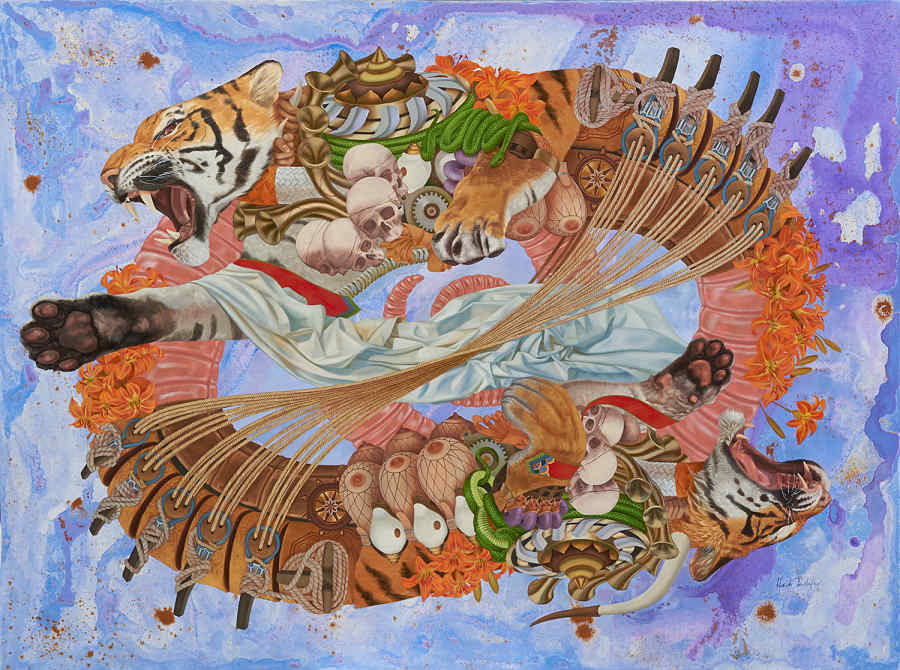
Describe your studio space!
I have had about 5-6 different studio spaces over the course of my career. I started out using my first apartment as a studio, and then I shared a small corner in a photographer’s 2000sft studio. Each time I would move, my studio got bigger, and I shared a space with two other professionals in a 1000sft space, then I shared it with one, then I had the space all to myself. Then I moved to live and work in a huge 3000sft loft set in a commercial building, with 50 feet of windows facing south to oversee the entirety of Montreal from the 8th floor; it was the quintessential artist’s loft in a former clothing manufacturing space. After a few years the rent went up too much, so I divided the space in half and lived and worked in 1500sft of space, and now I am back to my humble beginnings which is a little embarrassing to say.
I currently work in the corner of my kitchen and use an extra room upstairs as the drawing-room to research and prepare the drawings before I paint them. It actually works quite well and is well lit, although it is a far cry from the 3000sft studio space I had ten years ago. I’m not sure what I’ll do moving forward, I still seem to be able to work on large canvases and there aren’t many studio spaces that I know of in the neighbourhood where I live. I really don’t want to have to commute into the city each day; I would rather paint in my home and have the entire house strewn about with canvasses and photo references.
What do you hope 2021 will bring?
Omg. I hope 2021 will bring peace and communion in society, especially the US, and an end to this diabolical pandemic. I also hope it will bring a renewed effort to protect our environment globally. On a more personal note, I hope 2021 will bring a greater awareness of my work and what it is about since I feel that I have focused largely on commercial endeavours up unto this point. I keep getting various interviews posted online, so I’m hoping that the word will get out more and describe what I try to convey. This interview certainly helps, thank you for that!! So I can say that my year has so far been going quite well!


